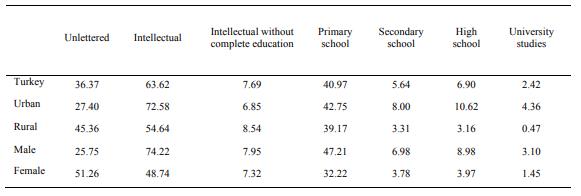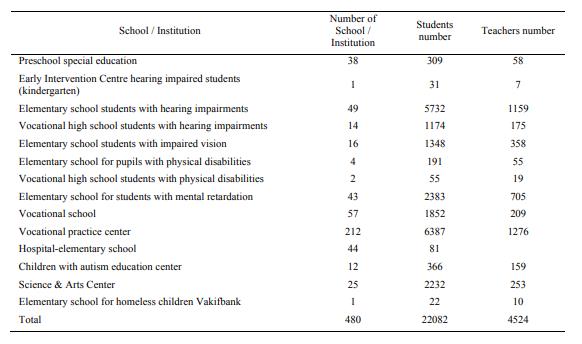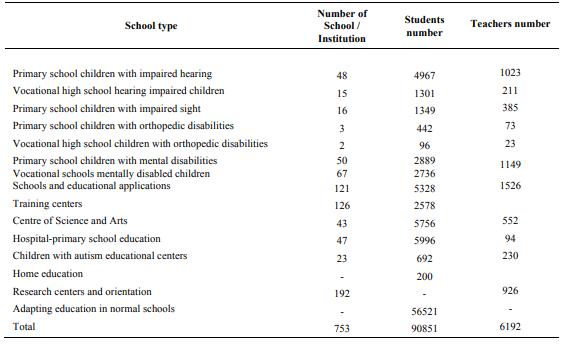Abstract
In the contemporary world there are many definitions of integration resulting from the idea of equality in education and the principle that people should be educated in the least restrictive environment where you will give a modern education is a prerequisite for democratization. Integrating people with special needs provides education on equal terms with children of the same age in the normal education programs according to the type and degree opportunities offered and resources need to be used. Kircaali-Iftar (1992) defines integration as an education that can be taught in general education classes provided children with special needs to ensure teacher and / or student with disabilities special education services. Therefore, integration is not only the formation of a special needs child with his peers in a normal house without receiving any special educational support. Rather education of students with special needs in general education classes will be continued with the support of special education. This article highlights the role of education through continuing education emphasizing the integration of people with special needs and providing educational support services, along with their peers in countries not belonging to the European Union. Through these apps, people with special needs may continue their education through integration in the same class with their peers without disabilities either in full-time and part-time. In the application program ala part-time students attend certain lessons or extracurricular activities with their peers without disabilities.
Keywords: Integrationspecial needsspecial programsextracurricular activitiesdisabilities
1.Introduction
Education is one of the fundamental human rights and is a process of programmed events and selected
to ensure social skills and personal development of individuals. The Universal Declaration of Human
Rights specifies that everyone has the right to education. Under the Convention on the Rights of the
Child, the signatory states agreed with the right to education of every child and that this will be done
based on the principle of ensuring equal opportunities.
The specific of the contemporary society is that produced a series of changes in the general attitude of
the community towards people with "special educational needs". Particularlly, people who have various
physical and mental disabilities constitute a group that calls from the community, social services and
interventions and also a psycho specialist. Such interventions involve a complex activity which envisages
prevention, identification, diagnosis and psycho-diagnosis, therapy and psychotherapy, appropriate types
of rehabilitation, education and re-education, expert advice and counseling and guidance. All these
measures aim ultimately socio-professional integration and monitoring further developments of the
person involved in the process. Achieving these objectives involves a type training of real psychological,
pedagogical, medical and social legal and teachers responsible for educating children with special needs.
How the school environment has a significant share in the recovery of children in difficulty, the role of
inclusive education should be inserted into an overall educational strategy. Restructuring of the education
and management reforms are still ongoing, have produced changes in Axiological education grid in
relation to the democratization of society, thus making enforcement of the right to education for all
children and equal chances of access to their education. In an attempt to provide a life with a degree of
autonomy enlarged vision of the need to change children with special needs by waiving labeling and
stigmatization is considered as an important objective.
Therefore, without discrimination, every country is responsible for the education of all individuals.
Equality in education is one of the fundamental principles of democratization.
In Turkey the right to education is guaranteed by Article 42 of the Constitution. Education in Turkey
are conducted under the supervision and control of the state, being on the landing of equal justice, safety
and health. Turkish education system has completed its current form by legislation which determine the
type and level of education and the principles of operation. Ministry of Education undertake an important
role in providing education services in both provinces of the country and foreign organizations.
2.Problem Statement
The general framework of the national education system in Turkey is determined by the National
Education Law number 1739 which lists the general purpose of national education, basic principles and
overall structure of the national education system in Turkey. "The right to education" and "equality and
opportunity in education" are among the basic principles of national education.
Educational services are inadequate for people with special needs and why these people need special
education. Special education is planned educational services aimed at individual and opportunity for such
persons to live independently. Development of special education cannot be considered independently of
other developments around the world. Development of special education is in accordance with our
developing democracy, which allowed the adoption of a more moderate and more positive perspective on
the variety of individual characteristics, as reflected in special education.

Similar to the special education in Europe also in Turkey, the development of this type of education
cannot be considered independent of social evolution but in line with the development of democracy,
which allowed while adopting a more moderate and more positive on the variety of individual
characteristics, so reflected in special education.
3.Research questions
The purpose of article is to assess the manner in which integration is carried out in schools for
children with special educational needs in a country not belonging to the European Union but which is
making major efforts for joining this space. Research questions: How it is structured the education system
in Turkey? What are the decision-central structures that ensure the implementation of educational
policies? What is the number of teachers relation to the number students? How many people with special
needs and their distribution is impaired, gender, place of origin? Whose special education management in
Turkey and how is it structured? How it is organized special education system in Turkey? What is the
number of schools that provide education for children with special needs and that is the manner of
organization and operation to these?
4.Purpose of the study
Education through integration that began to be applied in Turkey with Law number 2916 of the 1983
Act of children requiring special education continued with Decree number 573 of the 1997 Decree in
respect of the law for special education and not least with Regulation Services special Education in 2000.
These laws aim to turn students with special needs active members of the community and provide them
with an educational environment shared with other children who are developing normally and is under
legal in many European countries. And in the development plan is intended that pupils with special
educational needs be given priority method of integrated education.
The article analyzes the positive and negative aspects of integration and the results will provide a real
source of information on projects that the Ministry of Education will make for integration.
The article examines whether the transformation of traditional Turkish school in one with profound
meanings inclusive has infrastructure, material resources, human, legal and institutional. It follows that
the objectives of inclusive education aimed at combating non-schooling, dropout and school failure
through efforts that go beyond the barriers of material difficulties, personal, family or social facing
children. Meanwhile, the research results will reveal whether the objectives of inclusive education in
Turkey should aim to provide optimal learning conditions that give everyone a chance an equal start in
life in terms of education.
5.Research methods
The main research method is quantitative one. Data is gathered from secondary sources, namely
official statistics published by the Turkish government structures (Ministry of Education, Institute of
Statistics, the Higher Education Council), journals and national education law. This approach provides an
overview of the education system in Turkey and, in particular, to the special school. The research findings
may identify general pattern of functioning education system in Turkey and can be used as a starting
point for a comparative analysis of the education system in Romania or another Country, Member of the
U.E. Republic of Turkey's education system consists of two main parts: the "formal" and "non-formal education".

Formal education is classic and includes pre-school, primary, secondary and higher education
institutions. Non-formal education includes academic education and vocational training to citizens who
have never received formal education or have dropped out of school at any level (Akkok, 2001) (MEB,,
2006).
There are two educational institutions that control all activities of the Republic of Turkey: Milli
Egitim Bakanlığı (MEB) (Ministry of National Education) and Yüksekö Greta Kurulu (YGK) (Higher
Education Council). Both public and private education in pre-schools, schools and special educational
programs are under the control and responsibility of the Ministry of National Education (MEB, 2006). In
2005, there were 53 556 schools that provided formal and non-formal 17,491,124 633 835 students being
served by teachers (MEB, 2006).
6.General characteristics of persons with disabilities in Turkey
People with disabilities in the Republic of Turkey have equal rights with others benefiting from the
provisions of the law relating to the education of persons with disabilities. Of Turkey's population of
74,724,269, a total of 8.357 million people are disabled most of them in old age. The number of disabled
men is higher than women and the geographical layout most of them live in the Black Sea. While the
highest rate of disability is observed in people with physical disabilities, the lowest percentage observed
disability hearing disability (DIE, 2008). Research by gender, shows that physical disability, the sight,
hearing, mental and language disorders are present in men, while chronic diseases are present in women.
On the other hand, physical disabilities, vision, hearing, speech and mind are present in rural areas, the
number of people who have chronic diseases is higher in urban areas. The education level of people with
disabilities in Turkey is presented in Table 3.

According to Table 3, a 36% of the population is illiterate disabled people or about 3 million people
with disabilities. This rate is higher in rural areas. Since 27% of the female population of the Republic of
Turkey is illiterate (DIE, 2008), this requirement also applies to women with disabilities. More than half
of women with disabilities are illiterate. (Jordan, A., Kırcaali-İftar, 1992)
Another problem stems from higher education to the disabled. According to data from Table 3, it is
observed that disabled people continue higher studies in rate of 2.42%. Result that disabled people in
Turkey are unable to benefit from higher education. Disability Studies in Turkey are very limited. In
research carried out by the Prime Minister were tested expectations of disabled people from the
government (Table 4). It notes that financial support is one of the highest expectations of people with
disabilities (61%). The rate of people with disabilities who expect financial support is 68% in rural areas,
while about 55% are in urban areas. Approximately 59% of men and 64% of disabled women expect
financial support from organizations and institutions. Expectations regarding the education of disabled
persons is at the lowest level (2.42%). These results may be useful for analysis and policy directions for
reform. (Eres F., 2010).

7.Education of disabled people in Turkey
Special education is supervised and controlled by the Ministry of National Education of Turkey
(Cikili, Y.,1996). The education of children with disabilities is a matter of concern for the Ministry of
Education, under the principle of "equality and education" (MEB, 2007). In Turkey, educational services
are offered in special education schools for children and youth in five groups: visually impaired, hearing
impaired, physically disabled and mentally disabled people long-term illness. (Macid A. M., Cakiroglu A,
K. W. Malmgren, 2009). Of the children in all groups, persons in an optimal state included education in
public schools to benefit from education services through special education courses and education support
(MEB, 2008). The numerical values on Disability between 0-19 years are presented in Table 5 (DIE,
2008):

Analysis of data from Table 5 show that in Turkey there are a number of 1.15.636 disabled children,
boys outnumber girls being. The disability there are the following: 21.6% 22.2% physical disability and
visual disability. 36.2% of disabled children are between the ages of 0-19 years (DIE, 2008). No data are
available on the mentally handicapped.
The new legislation requires that special education does not isolate people with special educational
needs of their social and physical environment (MEB, 2000). It also requires that people with disabilities
who meet certain criteria to be included in normal schools for training courses benefit from special
education and further education (Sari, H., 2000). It envisages the education of persons with disabilities by
supporting them in mainstream classes or separate (MEB, 2008).
Special education consists of primary schools, vocational and technical schools with more programs,
schools of applications, special schools for autism education center for children and centers of science
and art, children's talented and gifted in Turkey (MEB, 2006). Children with disabilities are educated in
boarding schools or day care centers, except for children with autism and those included in the science
and art centers. Special education schools are summarized below (MEB, 2008).

8.Overview of special education schools

The data in Table 7 shows that there are a number of 3-6 students per teacher in special education in
Turkey. Because of the treatment period that can be variable, there are no statistics for children receiving
education in hospital or at home. Therefore, it appears that there are many teachers who teach children in
hospital and at home.
9.Conclusions
Analysis of the evolution of Turkey attest a paradigm shift from a normative model, segregationist
education based more on the medical model of disability treatment, an interpretative model based on the
social model of disability treatment. This model takes into account the respect for the right of all persons
to education and respect for the right of every child to have access to autonomy and responsibility.
Turkey's legal framework meets international standards and is based on the principle of education for
all, aimed to harness the learning potential of each child. It shows a concern and political will with regard
to inclusive practices and active engagement of government agencies in implementing inclusive
education.
In order to implement inclusive education in Turkey are developed structures / support services at
national, local and institutional perspective aiming to inclusion of children in mainstream schools. The
new support services created are based on the social model, the strengths and needs of students, and the
advantages and problems of each child and each family.
In Turkey there is the idea of placing children with special needs together with other children in
mainstream education and envisages taking all necessary measures and provide sufficient support for the
integration of a child. It ensured the education of individuals with special educational needs, the same
institutions, alongside their peers without disabilities. Against this background, educational services are
planned based on the educational performance of children's fundamental needs.
References
- Akkok, F. (2001). The past, present, and future of special education: the Turkish perspective, Mediterranean Journal
- of Educational Studies, 6(2), 15–22.
- Cikili, Y. (1996). The place and importance in Turkish national education system for the children who are in need of
- the special education. (Unpublished Doctoral dissertation, Ataturk Universitesi Sosyal Bilimler Enstitusu).
- Child Rights Convention, Art. 28. Available on-line at:
- http://www4.pmb.ro/wwwt/pactivi/Doc%20legislatie/Legislatie%20copii.pdf
- Devlet Istatistik Enstitusu (DIE) [Turkish Statistical Institute] (2008). Population and Development Indicators.
- Available on-line at: http://nkg.die.gov.tr Eres F. (2010). Special education in Turkey. US-China Education Review, ISSN 1548-6613, USA Apr. 2010, Volume 7, No.4 (Serial No.65) Jordan, A., Kırcaali-İftar, G., ve Diamond, C. T. P. (1992). Who has a problem, the student or the teacher?
- Differences in teachers' beliefs about their work with at-risk and integrated exceptional students. Int. Journal of Disability, Development 40(1), 45-62., 01/01/1992 Macid A. M., Cakiroglu O, Malmgren K. W., (2009). Special education in Turkey. International Journal of Inclusive Education, 13:3, 287-298.
- Milli Egitim Bakanligi. MEB (2000). The Turkish education system. Ankara: General Directorate of Foreign Relations Publishing.
- Milli Egitim Bakanligi. MEB (2006). Special education services. Ankara: Milli Egitim Basimevi.
- Milli Egitim Bakanligi. MEB (2007). Budget report for 2007. Ankara, Milli Egitim Basimevi.
- Milli Egitim Bakanligi. MEB (2008). Guide of special education and counseling services. Ankara:Milli Egitim Basimevi,19.
- Sari, H. (2000). An analysis of the policies and provision for children with SEN in England and Turkey.
- (Unpublished EdD Thesis), England: Oxford Brookes University, Westminster Institute of Education.
Copyright information

This work is licensed under a Creative Commons Attribution-NonCommercial-NoDerivatives 4.0 International License.
About this article
Publication Date
25 May 2017
Article Doi
eBook ISBN
978-1-80296-022-8
Publisher
Future Academy
Volume
23
Print ISBN (optional)
-
Edition Number
1st Edition
Pages
1-2032
Subjects
Educational strategies, educational policy, organization of education, management of education, teacher, teacher training
Cite this article as:
Drămnescu, M., & Enăchescu, V. (2017). Specific Approach Of Special Education In Turkey. In E. Soare, & C. Langa (Eds.), Education Facing Contemporary World Issues, vol 23. European Proceedings of Social and Behavioural Sciences (pp. 107-114). Future Academy. https://doi.org/10.15405/epsbs.2017.05.02.15

